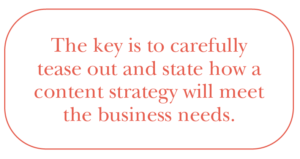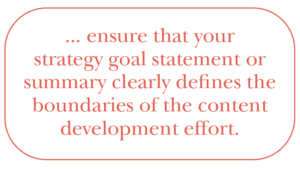By Debra Kahn | STC Senior Member
 Practitioners of content strategy do not have to go it alone when developing a strategy for a content project. Whether we are leading a digital transformation of existing content or the launch of a new website, we can learn much from our project management colleagues.
Practitioners of content strategy do not have to go it alone when developing a strategy for a content project. Whether we are leading a digital transformation of existing content or the launch of a new website, we can learn much from our project management colleagues.
In this publication nearly eight years ago, Scott Abel defined the role of a content strategist as “concerned with the actions, resources, costs, opportunities, threats, and timetables associated with producing content” that meet an organization’s business goals and support its overall vision.
That list of elements should ring familiar to project managers.
The Project Management Institute (PMI), an international association for project, program, and portfolio managers, states that project managers “have a broad and flexible toolkit of techniques, resolving complex, interdependent activities into tasks and sub-tasks that are documented, monitored, and controlled. They adapt their approach to the context and constraints of each project …”
That flexible toolkit and adaptable approach should ring familiar to content strategists.
While our tools and techniques might have evolved since 2013, we content strategists can find value in looking closely at the basic principles of project management.
Align with the Business Need
A Guide to the Project Management Body of Knowledge (PMBoK), the bible for project managers, states that “projects are initiated due to internal business needs or external influences.” Determining whether the business needs a fixed-scope project or a continuous improvement program is an important first step.
Based on the needs analysis, project leadership typically develops a business case and charters a project. These steps occur whether the project team uses the traditional waterfall (or phased) project methodology or a more iterative, agile project methodology. With the latter, the charter might evolve over time.
Similarly, successful content strategists tie their effort closely to a defined set of business needs. Generally, I’ve seen three categories of business needs drive a content project:
- Acquire more customers by repositioning existing products and services
- Improve customer satisfaction and/or business efficiencies to lower costs
- Offer new products or services
In ideal circumstances, the business needs driving the content strategy fall into only one category. But that is not always the case, especially in technology businesses. The key is to carefully tease out and state how a content strategy will meet the business needs.
For example, the fictional “Acme High Technology” might have the following stated business goal:
Acme High Technology will realize process efficiencies and cost savings, while maintaining current customer satisfaction levels, by integrating all data center systems into a standardized and automated service infrastructure that is managed through a global service portal.
The goal or charter of the content strategy might be stated this way:
To realize operational cost savings and efficiencies for the business, the service portal content and interfaces will guide data center technical and operations staff to quickly and accurately assess, effectively monitor, and efficiently respond to customer satisfaction issues in the data center, as well as enable the staff to efficiently and safely integrate, maintain, and troubleshoot systems in the new, standardized and automated service infrastructure.
Notice that the language of the content strategy goal does the following:
- Echoes the overarching business goal
- Identifies the audience
- Indicates the scope of the content project
- Encompasses user requirements
- Sets some standards for the quality of the work
These elements help to define and bound the content project, just as they would any other development project. I’ll provide more information on them later in this article.

Engage Stakeholders
The statement of a business goal should reflect an understanding of the project’s or the strategy’s stakeholders. The first step, always, is to identify the stakeholders — from the customer to the CIO and all the potential influencers in-between — as well as their expectations and level of influence on the project.
The PMBoK reminds us that stakeholders can see various types of “business value” in a project — both tangible and intangible. Tangible examples include monetary assets, market share, and tools. Intangible examples include brand recognition, reputation, and public benefit. Various project management data representation techniques offer additional ways to capture an understanding of a project’s stakeholders.
After you have an understanding of your stakeholders, frequent stakeholder communication becomes important. In her book, The Content Strategy Toolkit, Meghan Casey says “The first key to getting stakeholders on board and aligned is to have empathy for where they are starting from. The second is to bring them along for the journey …”
The PMBoK outlines techniques for planning, managing, and monitoring stakeholder engagement. I like to do an assessment from time to time, beyond the regular meetings and updates. One assessment tool offered in the PMBoK involves some emotional intelligence and a scorecard: the stakeholder engagement assessment matrix.
In this system, a “C” indicates the current level of engagement of the stakeholder, and D indicates the desired level of engagement to ensure the success of the project.
Focus on the User/Audience Needs
Long a staple of successful technical communication, the directive to “know your audience” and to design your content accordingly forms the foundation of content strategy. This directive also intersects with the project manager’s challenge to define and prioritize end-user requirements for project deliverables.
The PMBoK defines project and product requirements similarly: the “conditions or capabilities that are required to be present in a product, service, or result to satisfy an agreement or formally imposed specification.” It advises that a requirements record have enough detail to determine a baseline state against which progress can be measured. Many software tools are available for recording and tracking requirements.
The content strategist’s tool kit for recording audience discovery and requirements includes user personas or profiles, and task analysis. Inputs to these deliverables include demographic research, surveys, in-person interviews, site visits, and workplace observations.
In my 2020 blog post, “Tips for Developing a ‘Real’ User Profile for a Content Strategy,” I outline five steps I have followed to develop a set of relatable user profiles:
- Research the basic job-related tasks and backgrounds of all potential audience types
- Gather interview questions and contact information for audience interview candidates
- Conduct and record face-to-face interviews with target audience members
- Develop reasonably detailed “real” user profiles for the content development team
- Provide context to the team for those profiles
With these steps, I have been able to move beyond the generic user personas that are typical of marketing content strategy. For example, referring to the earlier content strategy goal statement, I would leverage these steps to profile representatives of the various technical and operations staff positions, including managers, working in the business’s data centers.
Scope the Work
Scoping is an exercise in “getting real” about goals and objectives. What is doable and what is “nice to have?”
To focus the effort, both the project manager and the content strategist typically compare the future state against the current state and perform a gap analysis. This step is particularly necessary if the deliverable is a new version of an existing product or content set.
For a traditional project, the project manager assesses the gap between the requirements gathered and the critical path to the stated business goals; then the project manager “progressively” manages the project to that scope. For an agile project, the project manager continually assesses the gap between what has been accomplished so far and what remains to be done or the backlog; thus the project scope evolves over time.
A content audit or a content inventory are a content strategist’s primary tools to perform a gap analysis. Both can help to scope the work and serve as a reference during development.
What is the difference between the two?
In their seminal book Managing Enterprise Content: A Unified Content Strategy (Second Edition), Ann Rockley and Charles Cooper tell us that a content audit is qualitative: the “process of actually looking at the content and assessing its value and opportunities for reuse.”
The content inventory, according to Kristina Halvorson and Melissa Rach in Content Strategy for the Web, is more quantitative. It provides “just the facts,” focusing more on listing content and its use and/or location.

However you identify and document the scope of the content project, ensure that your strategy goal statement or summary clearly defines the boundaries of the content development effort. For example, our earlier content strategy goal statement states that the content work encompasses service portal content and interfaces, but only so far as they “guide” and “enable” specific work requirements for the identified audiences.
Develop the Work Plan and Schedule
The outcome of the gap analysis effort is a work plan or workflow for the development project, which is designed to fill the gaps. But that is not as easy as it sounds.
You’ll often hear project managers speak of the triple constraints of schedule (time), cost (money and resources), and quality (scope creep). In other words, the work plan often encompasses compromises. That’s something we content strategists should bear in mind, too.
Project managers consider these constraints when developing the work breakdown structure or WBS, “a hierarchical decomposition of the total scope of work to be carried out by the project team to accomplish the project objectives and create the required deliverables,” according to the PMBoK. The WBS often gets input into a Gantt chart or other scheduling tool. The agile project manager considers cost and quality when developing a sprint.
Content strategists might not be directly involved in a work plan and schedule. But as Rahel Anne Bailie says in her 2013 Intercom article “A Methodology for Content Strategy,” the step after requirements gathering and scoping—the step she calls “interpretation—is “where the magic happens…where all the puzzle pieces fit together.”
When working on this type of interpretation for a content project, I like to ask the following questions:
- What type of content best meets the audience’s needs? (For example, DITA gives us the archetypes of task, concept, and reference.)
- What level of detail is needed?
- How best can the content be conveyed to the audience? (For example, table, illustration, video, help file, FAQ, chatbot?)
- How should differences among audiences be accommodated?
- How should the content be categorized? How can it be reused? And how is metadata applied?
- How does the content leverage or expand existing infrastructure? (For example, an existing information model? An existing reuse strategy?)
As you translate your interpretation into a work plan, workflow, or schedule, remember that content requires not only a development cycle but also some kind of governance of its life after it is published. How much maintenance will the content require in the future? How long a life will the content have?
Manage/Test Plan Components
As the development work progresses, project leadership becomes more of a support role. For both the project manager and the content strategist, this project phase typically includes these three types of activities:
- Helping the developers keep the big picture in mind while contributing to forward progress
- Overseeing proofs of concept (POCs) and other conceptualization and testing efforts
- Ensuring that the developers have the resources required to produce quality work efficiently
In the PMBoK, the first activity listed for this “manage and direct” phase is to “manage project knowledge.” It defines this activity as “the process of using existing knowledge and creating new knowledge to achieve the project’s objectives and contribute to organizational learning.” Outputs include process updates and a refined project plan.
Plan refinement is also part of the content strategist’s role. We might consider adding project management tools such as a risk register and a lessons learned register, which can be shared with management and other stakeholders.
Which brings me to the role of the POC in content strategy. Wireframes are great for content design and conceptualization, especially when a new, very different approach is being trial-ballooned. You can use wireframes to gather quick feedback from potential audiences.
But, in my experience, content developers need to test-drive a new approach, especially if it requires them to develop a different kind of content than they have previously. An example is troubleshooting content. The development team needs to understand what constitutes “good content” and find out where challenges might lie.
Asking a content developer or two to run trial content through a new or evolved template, process, or output target can reveal potentialities—good and bad—that no one thought of during the design phase. As a result of this proof of concept, templates and other job aids—such as process descriptions, scripts, style sheets, and tagging guides—can be improved before the new approach is rolled out to the entire development team. This rollout can be followed up with check-ins or interim reviews.
Monitor/Measure the Project’s Success
Interim reviews are part of the team’s monitoring and measuring effort, a set of processes that can also include oversight of and adjustments to the quality of the deliverables.
The PMBoK refers to “controlling” and “regulating” a project with these processes. It speaks of change requests and corrective and preventative actions. Those process steps might be too formal or cumbersome for a content development staff, but some kind of feedback process is helpful.
In my corporate job as a content strategist, I also wore an editor’s hat. I supported the team by providing developmental edits of initial efforts—applying standards that I had developed or maintained: style guides, style sheets, specialized templates, and terminology lists. The benefit of having dual roles was that I was able to observe—and learn from—how the content development team was implementing the content plan.
In that corporate position, I also implemented and applied learnings from a content quality measurement system. Leveraging concepts from Megan Gilhooly’s presentation “Customer-First Content: The Content Quality Flywheel,” from the 2018 Content Management Strategies/DITA North American Conference, I designed a system with three parts:
- Website metrics to measure visitor data and behavior
- Reviews of website comments and visitor surveys to assess user perceptions of the content
- Periodic internal reviews to assess content quality against team standards
A project manager’s measurement toolbox includes everything from periodic budget reports to work progress dashboards and can include sophisticated forecasting tools. PMI offers tool templates through its projectmangement.com website. Many content strategists use these or similar tools as part of a project communication strategy, especially on large content projects. The data gleaned from these tools can also be used to make course corrections or to justify project scope changes.
Another benefit of having a set of measurement tools is to celebrate successes. I believe that small successes should be celebrated regularly, and not only at the project close. I love that the “Consider These Servant Leader Responsibilities” section of the PMBoK advises us to “Create upward spirals of appreciation and good will.” Let’s enjoy those spirals.
DEBRA KAHN, PMP, (debra@dkconsultingcolorado.com) CEO of DK Consulting of Colorado, is a content solutions leader with 20+ years of experience in technical and business communication. That experience includes working as a technical editor for Sun Microsystems and as a content strategist for Oracle. She currently volunteers as Vice President of Marketing for PMI’s Mile Hi Chapter, which serves PMI members in Denver, northern Colorado, and southern Wyoming. Find Debra on her website, dkconsultingcolorado.com, on LinkedIn (www.linkedin.com/in/debkahn), or on Twitter (@dkconsultco).
References
Abel, Scott. 2013. “The Importance of Vision in Content Strategy.” Intercom 60 no. 5: 15-16.
Bailie, Rahel Anne. 2013. “A Methodology for Content Strategy.” Intercom 60 no. 5: 11-13.
Casey, Meghan. 2015. The Content Strategy Toolkit: Methods, Guidelines, and Templates for Getting Content Right. San Francisco: New Riders.
Fox, Alyssa. 2018. “The Case for a Global Content Strategy: A Leadership Case Study.” Intercom 65 no. 3: 9-12.
Gilhooly, Megan. “Customer-First Content: The Content Quality Flywheel” presentation, Content Management Strategies/DITA North American Conference. Denver, Colorado, 25 April, 2018.
Hackos, JoAnn T. and Janice C. Redish. 1998. User and Task Analysis for Interface Design. New York: John Wiley & Sons.
Halvorson, Kristina and Melissa Rach. 2012. Content Strategy for the Web. San Francisco: New Riders.
Kahn, Debra. 2019. “5 Intersects of Content Strategy and Project Management (Part 2),” DK Consulting of Colorado. Accessed 3 March 2021.
https://dkconsultingcolorado.com/2019/05/19/5-intersects-of-content-strategy-and-project-management-part-2/.
Kahn, Debra. 2020. “5 Intersects of Content Strategy and Project Management (Part 5),” DK Consulting of Colorado. Accessed 3 March 2021.
https://dkconsultingcolorado.com/2020/01/30/5-intersects-of-content-strategy-and-project-management-part-5/.
Kahn, Debra. 2020.“Tips for Developing a ‘Real’ User Profile for a Content Strategy.” DK Consulting of Colorado. Accessed 3 March 2021.
https://dkconsultingcolorado.com/2020/09/20/tips-for-developing-a-real-user-profile-for-a-content-strategy/.
Project Management Institute. 2017. A Guide to the Project Management Body of Knowledge (PMBoK guide), Sixth Edition. Newtown Square, PA: Project Management Institute.
Rockley, Anne and Charles Cooper. 2012. Managing Enterprise Content: A Unified Content Strategy, Second Edition. San Francisco, CA: New Riders.



